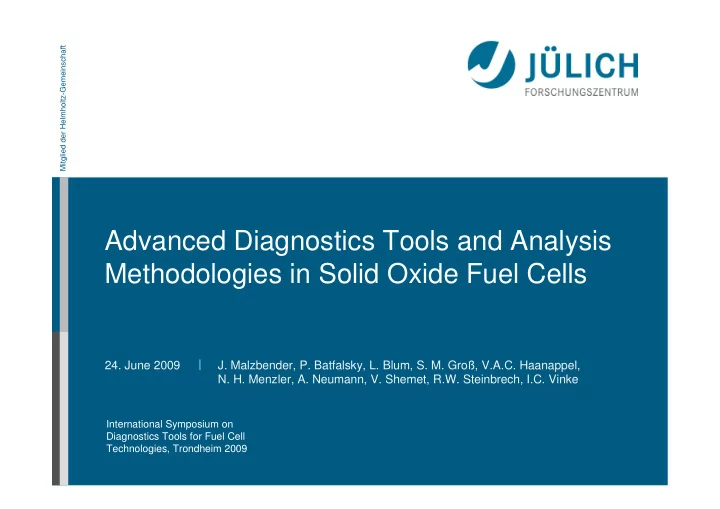

Mitglied der Helmholtz-Gemeinschaft Advanced Diagnostics Tools and Analysis Methodologies in Solid Oxide Fuel Cells 24. June 2009 J. Malzbender, P. Batfalsky, L. Blum, S. M. Groß, V.A.C. Haanappel, N. H. Menzler, A. Neumann, V. Shemet, R.W. Steinbrech, I.C. Vinke International Symposium on Diagnostics Tools for Fuel Cell Technologies, Trondheim 2009
� Role of “Advanced Diagnostics Tools and Methodologies” � Post operation methodology � Post operational analysis methods � Post operation analysis procedure � Example G-Design stack � Improved design 24. June 2009 Folie 2
Role of “Advanced Diagnostics Tools and Methodologies” Short stack for SOFC development Post Operation F-design Analyses Light weight stack (APU application) Diagnostics Tools / CS-design Methodologies Operation Design Advanced characterization methods are an essential element to understand the stack Fabrication performance within the frame- work of a systematic testing 24. June 2009 Folie 3
Post Operation Methodologie � Disassembling with selected experts depending on expected degradation mechanism. Experience in synthesis, production, interaction, thermo- mechanics, corrosion, thermo-chemistry, sealants, stack / system operation, single cell testing, microscopy, SEM � 108 dissections from 8.2002 to 9.2008. � Electro-chemical results and irregular events are considered. � A digital photographic image is taken of every stack plane. � Unusual observations are investigated microscopically during disassembling. � After dismantling more detailed SEM (TEM) investigation are carried out. � Every stack opening is discussed in a subsequent meeting, suggesting further detailed follow up work. � Reports are passed on to selected members of the SOFC development team. � Selected results are presented to the entire SOFC team in semi-annual meetings. 24. June 2009 Folie 4
Post Operational Analysis Methods Materialography & Image analysis Macroscopic changes, color SEM and EDX Microscopic / structural changes, qualitative chemical analysis, Wet chemical analysis quantitative, coarse localized SIMS quantitative, localized Thermography, computer tomography short circuit localization, porosity XRD structural changes TEM local changes, interfaces, reactions Leakage, liquid dye inspection localization of leakages 24. June 2009 Folie 5
Post operation analysis procedure Example G-Design stack (G1002-04) Investigation of degradation and failure by comparison of electrochemical results with stack dismantling results low power output G-Design problems : high degradation rate 1,2 1,2 1,1 Alterung 37.0 ± 0.3% in 1000 Stunden 1,0 1,0 über 299 Stunden Alterung 23.0 ± 0.1% 0,9 in 1000 Stunden Stromdichte / A/cm über 314 Stunden 0,8 0,8 Spannung / V 0,7 Leck in der Dampfringleitung 0,6 0,6 0,5 0,4 0,4 2 0,3 Alterung 10.4 ± 0.1% Alterung 35.3 ± 0.1% 0,2 0,2 in 1000 Stunden in 1000 Stunden über 803 Stunden über 644 Stunden 0,1 0,0 0,0 0 200 400 600 800 1000 1200 1400 Zeit / h 24. June 2009 Folie 6
Ceramic glue shows partly red coloring and bubbles. In addition a short circuiting to the next cassette was detected. Sealing of cell: ceramic glue Sealing to next layer: glass- ceramic Before further dismantling took place the origin of the short circuiting was investigated using infrared camera imaging (thermography). 24. June 2009 Folie 7
Origin of the short circuiting was a deformation of the manifold. D5 Mechanically damaged contact layer 24. June 2009 Folie 8
Origin of low power output Stack G1002-3 Cathode side Standard F2060-1 Contact Air channel ~ 3,5 - 4 mm Air channel Contact ~ 0,2 – 0,3 mm Air channel Trace of the contact width Small contact width compared to standard design 24. June 2009 Folie 9
High degradation rate Formation of Cr 2 O 3 on the electrolyte Edge of the cell near the sealant Element Mass Atom Comp. Form % % % Cr K 68.4 40 100 Cr 2 O 3 O 31.6 60 24. June 2009 Folie 10
High degradation rate Modified contact layer Einbett Crofer22 Einbettmasse masse APU first New phases LCC10 MnOx Mass Atom Element Comp. Form % % % Cr K 14.5 11.8 21.3 Cr 2 O 3 Mn K 25.4 19.5 32.8 MnO Co K 0.97 0.69 1.2 CoO Cu K 2.8 1.8 3.5 CuO La L 35.2 10.7 41.3 La 2 O 3 O 21.2 55.6 24. June 2009 Folie 11
High degradation rate Chromia composites near the three phase boundary Element Mass Atom Comp. Form % % % Cr K 4.5 3.7 6.5 Cr 2 O 3 Mn K 14.6 11.3 18.9 MnO Zr L 37.7 17.6 50.9 ZrO 2 La L 20.2 6.2 23.7 La 2 O 3 O 23.0 61.3 24. June 2009 Folie 12
Problem: Solution: � Short circuit due to local upwards bending � Application glass-ceramic support of the manifold (creep effect) point � Cr 2 O 3 reaction products (from gas phase) � Substitution of ceramic glue by glass were detected on the surface of the – ceramic sealant � Components of the ceramic glue electrolyte � New reaction products were detected in could be confirmed, a follow up stack in the contact layer (influence of the ceramic the same design with glass – ceramic glue) sealant had a degradation of (2,6-2,8)% � Chromia composites were found near the / 1000h compared to (23-35%). three-phase boundary which might be associated with the high degradation 24. June 2009 Folie 13
Application point of glass-ceramic support point Cracks in cell, green color suggests re-oxidation Manifold bend Manifold bend Application point of glass- towards anode side towards anode side ceramic support point 24. June 2009 Folie 14
Cut Air inlet Air outlet Results are short circuit or cell Large manifold made from thin metal fracture sheets is not geometrically stable at high temperatures 24. June 2009 Folie 15
Improved Design Using a combination of metallic and glass-ceramic sealants. Significantly reduced size of unsupported manifold. In addition asymmetric cell to permit smaller in-plane gradient on thermal cycling. 24. June 2009 Folie 16
Stack-Dismantling Rolf Steinbrech Peter Batfalsky Ico Vinke Norbert Menzler Jürgen Malzbender Vincent Haanappel Thank you for your attention 24. June 2009 Folie 17
Recommend
More recommend